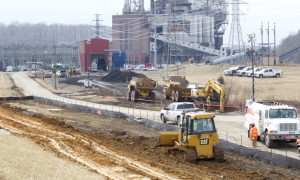Duke Energy said on Monday afternoon that between 50,000 to 82,000 tons of coal ash and up to 27 million gallons of water were released from a pond at its retired coal fired power plant in Eden, NC, and spilled into the Dan River.

Re-enforcing and patching the berm to the ash basin at the Duke Energy Dan River Steam Station in Eden, N.C.
Photo by Joseph Rodriquez, News & Record
Duke said a 48-inch stormwater pipe beneath the unlined 27-acre ash pond broke Sunday afternoon, and tens of thousands of tons of coal ash and water drained into the pipe before spilling into the Dan River. Duke Energy says that the dam along the river remains secure and has not been affected.
Duke did not issue a press release to inform the public until Monday afternoon, more than 24 hours after the spill occurred. Duke said it notified local emergency managers and the N.C. Department of Environment and Natural Resources on Sunday afternoon. Duke says the leak has been temporarily stopped and they are working on a permanent solution. Duke has 14 coal fired power plants in the state, seven of which have been retired.
The closest community downstream from the spill is Danville, VA, which takes its water from the Dan River only six miles from the pond. Officials are saying that water samples confirm that the water leaving the city’s treatment facility meets public health standards.
“All water leaving our treatment facility has met public health standards,” said Barry Dunkley, division director of water and wastewater treatment for Danville Utilities. “We do not anticipate any problems going forward in treating the water we draw from the Dan River.”
Coal ash, the toxic waste material left after coal is burned, contains arsenic, mercury, lead, and more than a dozen other heavy metals. Studies from the EPA have found that people living within one mile of unlined coal ash ponds can have a 1 in 50 risk of cancer.
This coal ash spill is the third-largest in U.S. history. In 2008, more than a billion gallons of coal ash slurry spilled at the Tennessee Valley Authority’s Kingston coal plant in Tennessee.
The Dan River coal ash spill is the latest in a string of industrial accidents that have jeopardized the environment and health of citizens downstream.



